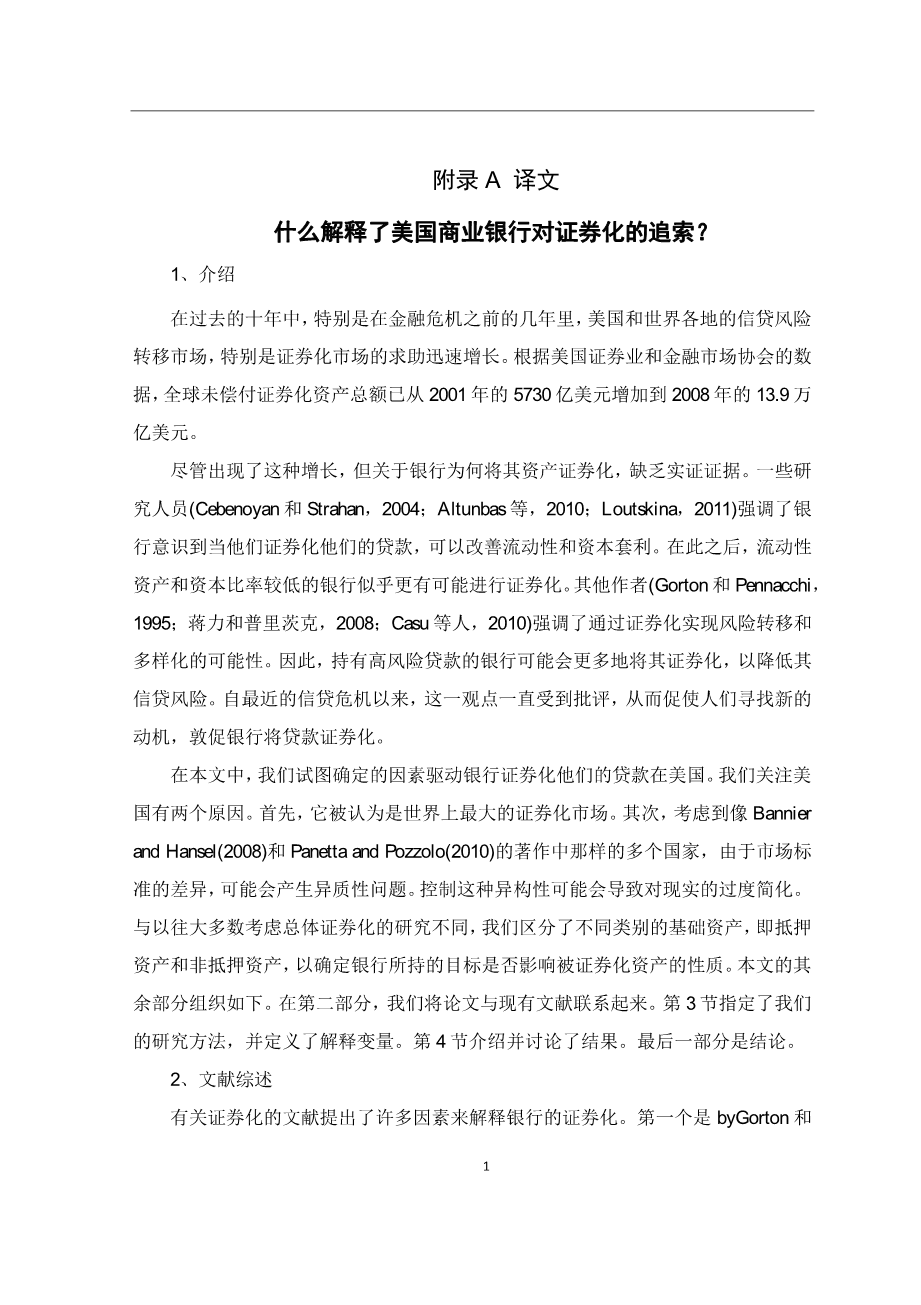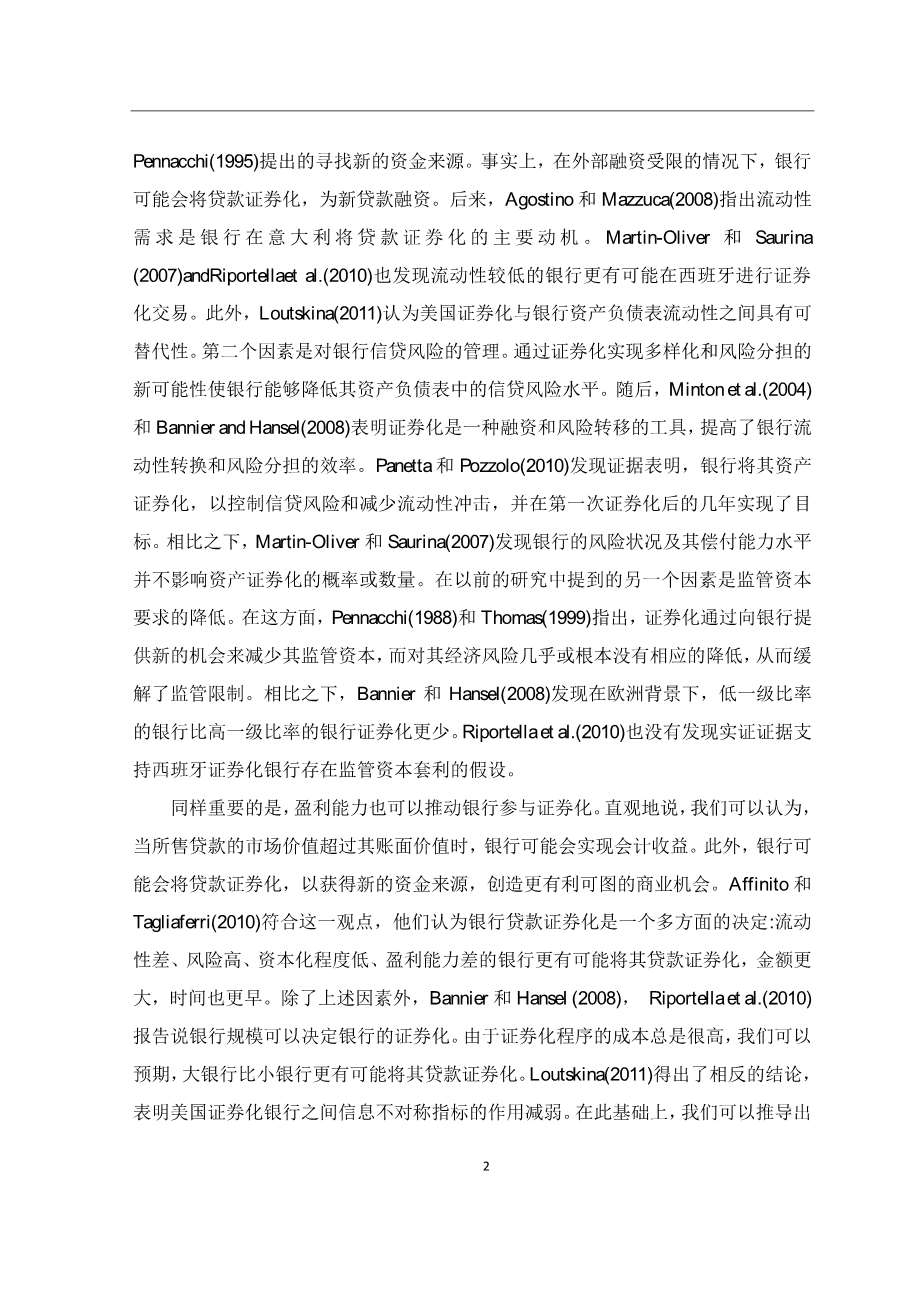附录B 外文原文
What explains the recourse of US commercial banks to securitization?
- Introduction
The recourse to credit risk transfer markets and particularly securitization markets has grown rapidly in the USA and all over the world during the past decade, especially during the years before the financial crisis. According to the data from the Securities Industry and Financial Market Association, the global amount of securitization outstanding has increased from US$573 bn in the year 2001 to US$13.9 trillion in the year 2008.
Despite this growth, there is scant empirical evidence on why banks securitize their assets. Some researchers (Cebenoyan and Strahan, 2004; Altunbas et al., 2010; Loutskina, 2011) stressed the liquidity improvements and capital arbitrage that banks realize when they securitize their loans. Following that, banks with less liquid assets and low capital ratios seem to be more likely to securitize. Other authors (Gorton and Pennacchi, 1995; Jiangli and Pritsker, 2008; Casu et al., 2010) emphasized the risktransfer and diversification possibilities through securitization. Hence, banks with risky loans may securitize more to reduce their credit risks. This argument had been criticized since the recent credit crisis, leading thus to search for new motivations that urge banks to securitize their loans.
In this paper, we attempt to determine the factors that drive banks to securitize their loans in the USA. We focus on the USA for two reasons. First, it is considered as the largest securitization market in the world. Second, considering more than one country like in the works of Bannier and Hauml;nsel (2008) and Panetta and Pozzolo (2010) may create a problem of heterogeneity due to differences in markets standards. Controlling for this heterogeneity may lead to oversimplify the reality.
Unlike most of the previous studies that considered the aggregate securitization, we distinguish between different categories of underlying assets, namely, mortgage assets and non mortgage assets to identify whether the objective carried by the bank affects the nature of assets being securitized.
The rest of the paper is organized as follows. In Section 2, we relate the paper to the existing literature. Section 3 specifies our research methodology and also defines the explanatory variables. Section 4 presents and discusses the results. The final section concludes.
- Review of previous studies
The literature related to securitization proposes many factors which explain bankrsquo;s recourse to securitization. The first one advanced byGorton and Pennacchi (1995)is the search of new funding sources. Indeed, banks may securitize their loans to finance new loans in the face of restricted availability of external financing. Later, Agostino and Mazzuca (2008)state the need of liquidity as the principal motive for banks to securitize their loans in Italy.Martin-Oliver and Saurina (2007)andRiportellaet al.(2010)find also that banks with less liquidity are more likely to engage in a securitization transaction in Spain. Moreover, Loutskina (2011) argues in favor of substitutability between securitization and banksrsquo; balance sheet liquidity in the USA.
The second factor is the management of bankrsquo;s credit risk. The new possibilities of diversification and risk sharing through securitization allow banks to reduce the level of credit risk in their balance sheets. Following that, Minton et al. (2004) and Bannier and Hauml;nsel (2008) show that securitization is a tool of funding and risk transfer that increases the efficiency of banksrsquo; liquidity transformation and risk sharing.Panetta and Pozzolo (2010)find evidence that banks securitized their assets to contain credit risk and reduce their exposure to liquidity shocks and that goals were achieved in the years following the first securitization. By contrast,Martin-Oliver and Saurina (2007)find that the risk profile of the bank, and its solvency level do not impact the probability or the amount of assets securitized.
Another factor mentioned in previous studies is the reduction of regulatory capital requirements. In this line, Pennacchi (1988) and Thomas (1999) state that securitization alleviates regulatory restrictions by providing banks with new opportunities to reduce their regulatory capital with little or no corresponding reduction in their economic risks. By contrast,Bannier and Hauml;nsel (2008)find in the European context that banks with low Tier-1 ratios securitize less than banks with high Tier-1 ratios. Riportella et al. (2010) find also no empirical evidence to support the hypothesis regarding the existence of regulatory capital arbitrage in securitizer banks in Spain.
It is also important to note that profitability can also drive bankrsquo;s engagement in securitization. Intuitively, we can argue that banks may realize accounting gains when the market value of loans sold exceed their book values. Moreover, banks may securitize their loans to obtain new funding sources for more profitable business opportunities. Conforming to this idea, Affinito and Tagliaferri (2010) establish that bank loan securitization is a many sided decision: banks that are less liquid, high risky, less capitalized and less profitable are more likely to securitize their loans, for a larger amount and earlier.
Apart from the factors indicated, Bannier and Hauml;nsel (2008), Riportella et al. (2010) report that bank size can determine bankrsquo;s recourse to securitization. As the securitization program is always costly, we can expect that large banks are more likely to securitize their loans than small banks. Loutskina (2011) concludes however to opposite results, signaling a reduction of the role of size as an indicator of informational asymmetry between securitizer banks in the USA.
Based on
剩余内容已隐藏,支付完成后下载完整资料


英语译文共 8 页,剩余内容已隐藏,支付完成后下载完整资料
资料编号:[413850],资料为PDF文档或Word文档,PDF文档可免费转换为Word


